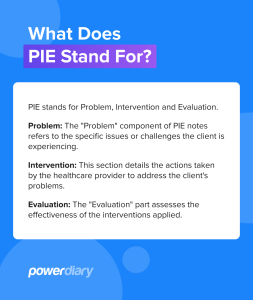Accurate and insightful records are essential for allied health professionals, whether you’re a counselor, social worker or psychologist. PIE (Problem, Intervention and Evaluation) notes help you track client progress, the interventions you’ve applied and the outcomes of those interventions.
This simple yet effective documentation method provides a clear, ongoing record of treatment, which is crucial for providing quality care.
In this article, we’ll explain the basics of PIE notes and show how they can be integrated into your practice.
Let’s get started!
What Are PIE Notes?
PIE notes are a structured method of documentation used by mental health practitioners to capture the critical elements of the client care journey.
These notes allow professionals to succinctly record a client’s challenges, the actions taken to address these challenges and the results of interventions. This framework helps maintain clear and focused records.
Mental health professionals use PIE notes to ensure that every aspect of the client’s treatment is documented and easy to follow. This form of documentation is useful in multidisciplinary teams where multiple practitioners may be involved in a client’s care, as well-written notes ensure everyone is on the same page.
Benefits of Well-Written PIE Notes
Well-crafted PIE notes bring numerous advantages to mental health practices.
Here are just a few:
- Time savings: Efficient documentation processes allow practitioners to spend more time with clients and less on paperwork.
- Consistent Documentation: Clear, structured notes ensure that all necessary information is recorded accurately and professionally.
- Ease of Reference: Well-organized notes make it easy to retrieve information, aiding in ongoing client assessment and the continuity of care.
- Compliance with Professional Standards: Adhering to a framework like PIE helps ensure compliance with industry standards and legal requirements.
- Demonstrates Commitment to Quality Care: Maintaining detailed and systematic notes reflects a dedication to providing high-quality care and monitoring client progress effectively.
- Provides Snapshot of Client’s Journey: The Problem, Intervention, Evaluation approach offers a holistic and structured snapshot of not only how the therapist intercepted the presenting problem but also the effectiveness of the chosen intervention, so that adjustments can be made if necessary.
- The Long View: Well-documented interventions drive better patient outcomes, ultimately driving client retention and revenue growth.
What Does PIE Stand for?
PIE is an acronym used in mental health documentation to streamline the recording of client encounters. It stands for Problem, Intervention and Evaluation. Each component of the PIE framework stands for a note section and serves a distinct purpose.
Problem
The “Problem” component of PIE notes refers to the specific issues or challenges the client is experiencing. This could include a range of mental health symptoms, situational problems or behavioral difficulties.
Documenting the problem accurately is crucial as it sets the stage for identifying appropriate interventions. Here, one must clearly describe the client’s current state or presenting concerns.
This can be grounded in your objective observations, client self-reports or assessments.
Intervention
This section details the actions taken by the healthcare provider to address the client’s problems. This may encompass a variety of strategies, such as therapy sessions, prescribed medications, community resource referrals or specific therapeutic exercises.
Documenting this component involves outlining the method, rationale and any modifications made during the treatment process.
Evaluation
The “Evaluation” part assesses the effectiveness of the interventions applied. It considers the client’s response and the overall progress made towards resolving the initial problems. This section is vital for determining whether the chosen course of action is successful or if adjustments are necessary.
Evaluation can include measurable changes in symptoms, client feedback and practitioner observations. It helps in guiding future care and provides a critical feedback loop for ongoing treatment planning.
What Is the Difference Between PIE Notes & DAP Notes
PIE and DAP notes are both popular methods of documentation used by mental health professionals, but they serve slightly different purposes and follow different structures.
Understanding the distinctions between these two formats can help practitioners choose the one that best suits their clinical style and client needs.
PIE notes are particularly beneficial for evaluating treatment effectiveness, making them a valuable tool for ongoing assessment and adjustment of therapeutic strategies. This is one of the reasons PIE notes are used in the nursing field.
DAP notes, however, are particularly useful for their comprehensive planning section, which outlines future steps and integrates them with the assessment findings, providing a clear roadmap for future sessions.
DAP Notes
DAP stands for Data, Assessment and Plan.
This format is structured as follows:
- Data: This section includes the raw information gathered during a session, such as client statements and observable behaviors.
- Assessment: The assessment interprets the data, offering a clinical judgment or diagnosis based on the information gathered.
- Plan: The plan outlines the steps to be taken moving forward, including changes to therapy if needed, goals for the next session and any homework for the client.
Benefits of Each Format
Both PIE and DAP notes offer benefits, and the choice between them may depend on personal preference and specific clinical needs.
PIE and DAP notes provide a framework for documentation and help ensure that mental health professionals provide informed, responsive and effective care. The choice between using PIE or DAP notes can depend on the specific demands of the practice setting and the preferences of the practitioners involved:
- PIE notes may be useful for a cyclic approach to care, where continuous evaluation is crucial. They allow for ongoing adjustment and are straightforward, which may enhance clarity and focus on outcomes.
- DAP notes provide a more granular view of each session, capturing detailed observations and plans. This can be especially useful in complex cases where detailed data needs to be documented systematically to inform a thorough assessment and detailed treatment planning.
- Quality Control and Evaluation: Regular and systematic evaluation sections in PIE notes allow for ongoing monitoring of treatment effectiveness, providing an essential tool for quality control in mental health practice.
Tips for Writing Effective PIE Notes
Writing effective PIE notes is a skill that can enhance the quality of care provided. Efficient and well-crafted PIE notes streamline the documentation process and improve the clarity and effectiveness of communication among healthcare providers. This can lead to better client outcomes, more cohesive care teams and enhanced adherence to treatment protocols.
Here are some practical tips to enhance the quality of your PIE notes:
1. Be Concise but Comprehensive
Focus on including all relevant information without overwhelming the note with unnecessary details. Aim for clarity and brevity, ensuring that each note is easy to read and understand by others who may be involved in the client’s care.
2. Use Clear, Jargon-Free Language
Avoid using overly technical language or jargon that might not be easily understood by all members of a multidisciplinary team. The goal is to make the notes accessible to everyone needing to reference them.
3. Stick to the Facts
In the Problem section, describe what you observe directly or what the client has reported without inferring or assuming. Stick to facts and observable behaviors to maintain objectivity.
4. Document in Real-Time or Promptly After Sessions
Writing notes immediately after sessions – or even during, if feasible – helps in capturing details accurately while they’re fresh in your mind. This practice reduces the chances of omitting crucial information.
5. Consistently Review and Revise
Regularly review your notes to ensure consistency and accuracy over time. This habit is essential for tracking progress effectively and adjusting treatment plans as needed based on accurate historical data.
6. Be Specific in Describing Interventions
Detail exactly what interventions were made during a session, including the type of therapeutic techniques used, any homework assigned or referrals made. This precision helps maintain continuity in treatment approaches, especially when multiple providers are involved.
7. Record Outcomes in the Evaluation
Clearly state whether the interventions were effective in addressing the problems. Use specific outcomes and observations to support your evaluation. If the results were unexpected, document this assessment and consider alternative strategies.
8. Include Client Feedback
Document any feedback the client provides about their own progress or the treatment they are receiving. This inclusion not only enriches the evaluation but also promotes client-centered care.
9. Use Bullet Points and Structured Formatting
Organize information using bullet points, headings or other structured formats to make the notes easy to scan and retrieve information quickly. This formatting is particularly useful in fast-paced environments.
10. Maintain Ethical Standards and Confidentiality
Always ensure that your documentation adheres to ethical guidelines and maintains client confidentiality. Avoid including any information that isn’t directly related to the treatment and care of the client.
11. Use Practice Management Software
Effective practice management software enhances the efficiency and security of PIE notes. These digital solutions offer tools that streamline documentation and ensure that all client records are securely stored and easily accessible to approved personnel.
PIE Note Example
This example PIE note reflects a clear and structured approach to documenting a mental health session. The Problem is identified based on the client’s symptoms and self-report, Interventions are outlined with specific actions and rationale, and the Evaluation assesses the immediate effectiveness of the interventions while setting the stage for ongoing treatment.
Let’s dive in:
Problem
- The client presented with heightened anxiety symptoms this week, reporting increased worry about upcoming work commitments.
- The client reported sleep disturbances and lapses in concentration.
- The client described feeling “on edge” daily and has noticed an uptick in irritability with family and coworkers.
Intervention
- Cognitive Behavioral Therapy (CBT) Techniques: Applied CBT to help the client challenge their negative thought patterns about work-related failures and reframe these thoughts more positively.
- Relaxation Strategies: Guided the client through a progressive muscle relaxation exercise during the session to help manage physical symptoms of anxiety.
- Homework Assignment: The client was assigned to keep a daily journal of their anxiety triggers and their responses to those triggers using techniques learned in therapy.
Evaluation
- The client responded well to the relaxation exercise, noting an immediate decrease in physical tension and expressing a desire to incorporate this regularly.
- They struggled somewhat with cognitive reframing techniques but showed a willingness to continue practicing these.
- The client agreed to the homework assignment enthusiastically, indicating a proactive attitude toward managing their anxiety. Follow-up in the next session will focus on reviewing the anxiety journal and further enhancing cognitive reframing skills.

Improve Your Clinical Notes with Power Diary
A strategic note-writing process is crucial for ensuring optimal care for clients and maintaining professional compliance.
One effective way to enhance the efficiency and quality of your documentation is by leveraging practice management software. With features tailored to the needs of mental health professionals, Power Diary helps ensure that your notes are compliant and comprehensive.
Power Diary offers a 14-DAY Free Trial, no credit card required. Enhance your professional practice today and experience firsthand how Power Diary can transform your note-taking.






